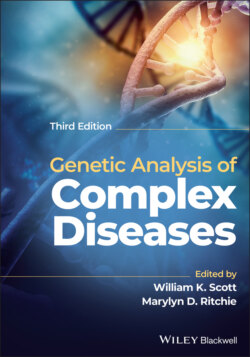Читать книгу Genetic Analysis of Complex Disease - Группа авторов - Страница 37
Genes and Chromosomes
ОглавлениеGenes are organized as linear structures called chromosomes, with many thousands of genes on each chromosome. Each chromosome has distinguishable sites, known as centromeres that aid in cell division and in the maintenance of chromosome integrity. The centromere is visualized as the central constriction on a chromosome, and it separates the p (short) and the q (long) arms from one another. The centromere enables correct segregation of the duplicated chromosomal material during meiosis and mitosis. Telomeres are present at both ends of the chromosome and are required for stability of the chromosomal unit.
Using appropriate staining techniques, the chromosomes in a cell can be analyzed under the microscope following cell culture and the arrest of cell division at metaphase (when the chromosomes have duplicated and condensed). At this stage of the cell cycle, a chromosome has two double‐stranded DNA molecules. Together, the strands are called sister chromatids. The sister chromatids are held together by the centromere. Photographs are magnified, and the chromosomes are arranged into a karyotype. The normal human chromosome complement consists of 46 chromosomes arranged in 23 pairs, with one member of each pair inherited from each parent (Figure 2.6). The first 22 pairs, called autosomes, are arranged according to size and are the same in males and females. The pair of sex chromosomes generally predicts an individual’s biological sex. Most females have two X chromosomes, whereas males have one X chromosome inherited from the mother and one Y chromosome inherited from the father. Therefore, the sex of an individual is primarily determined by the contribution of the father.
Figure 2.6 A G‐banded human male karyotype.
(Source: Courtesy of Mazin Qumsiyeh, Duke University Medical Center, Durham, NC.)
Because two copies of each chromosome are present in a normal somatic (body) cell, the human organism is diploid. In contrast, egg and sperm cells have haploid chromosomal complements, consisting of a single member of each chromosome pair. The correct number of chromosomes in the normal human cell was finally established in 1956, three years after the double‐helical structure of DNA was described, when Tjio and Levan (1956) demonstrated unequivocally that the chromosomal complement is 46.
Regions of chromosomes are defined by patterns of alternating light and dark regions called bands, which become apparent after a chemical treatment has been applied. One of the most common types of banding process, called Giemsa or G banding, involves digesting the chromosomes with trypsin and then staining with a Giemsa dye. G banding identifies late‐replicating, heterochromatic regions of DNA; these are the dark bands. Other chemical processes will produce different banding patterns and identify unique types of DNA.
A specific genetic locus can then be defined quite precisely along a chromosome, such as the gene FRAXA (fragile X syndrome), which is located on the X chromosome at band q27.3. Alternatively, its localization may be specified as an interval flanked by two genetic markers. Any two loci that occur on the same chromosome are considered to be syntenic or physically linked. The location of two loci on the same arm of the chromosome is specified by their positions relative to each other and to the centromere. The gene closer to the centromere is termed centromeric or proximal to the other; similarly, the gene further from the centromere is distal or telomeric to the other (Figure 2.7).
Figure 2.7 The myotonic dystrophy (DM) and insulin receptor (INSR) genes are distal (telomeric) to the ryanodine receptor 1 and CADASIL, respectively; RYR1 and CADASIL are proximal (centromeric) to DM and INSR, respectively.
The X and Y chromosomes vary in their genetic composition except for an area at the distal end of the p arm of each, termed the pseudoautosomal region. The pseudoautosomal region behaves similarly to the autosomes during meiosis by allowing for recombination of the sex chromosomes. Just proximal to the pseudoautosomal region on the Y chromosome are the sex‐determining region on the Y and testes‐determining factor genes, which are critical for the normal development of male reproductive organs. When a recombination event extends past the boundary of the pseudoautosomal region and includes one or both of these genes, sexual development will most likely be adversely affected. For instance, the rare occurrences of chromosomally XX males and XY females are due to such aberrant recombination.
